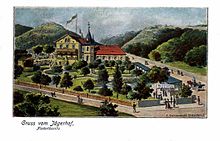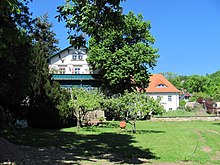"Zum Jägerhof" inn
The former inn "Zum Jägerhof" is located at Dr.-Rudolf-Friedrichs-Straße 27 in the Niederlößnitz district of the Saxon city of Radebeul . Today, the group of buildings, which consists of several structures, is an apartment building. The property west of the Dr.-Rudolf-Friedrichs-road, this is in the conservation area Historic vineyard landscape Radebeul and in the conservation area Lößnitz . The property is listed on the list of monuments under the name Jägerhof ; the nearby Besenwirtschaft at the half-timbered house Auf den Bergen 11 uses the name Jägerhof im Paradies derived from it due to its location at the foot of the Paradies vineyard .
description
The together with later extensions under monument protection standing, former inn is a group of buildings on a sloping south-facing plot with vast gardens between Dr.-Rudolf-Friedrichs-Strasse in the east and the Jägerhofstraße the southwest and west. Directly to the west of Jägerhofstrasse is the Radebeul Weinlage Paradies (with the former Berggasthaus Paradies in the west ) on the so-called Welzig Mountains .
Seen from the south, the simple structure of the old vineyard house lies across to the right. This plastered building, which borders on Dr.-Rudolf-Friedrichs-Strasse on the narrow side, is two-story; it has a tiled hipped roof with bat dormers .
To the left of the vineyard house and towards the south, the roughly square restaurant building joins a lower connecting building at right angles. The two-storey building in the Swiss style stands on a quarry stone base and has a flat, overhanging gable roof with slate covering . The facades are plastered, with corner blocks at the corners. The top floor has half-timbering. To the south towards the garden there is a wide porch in the gable end. On the east side of the building there is an octagonal " stair tower with a pyramidal helmet , the dormer-like side turrets of the tower tower recently restored [before 2006]."
The fencing is carried out by a stone wall stepped because of the sloping terrain.
history
The core of today's group of buildings is a vineyard house from around 1750. The two owners from 1775, the Electoral Saxon Chamber Secretaries Friedrich Meuser and Karl Friedrich Heerwagen, are known by name. In 1789 the property belonged to Henr. Carl. born Beyer, widow of the secret finance secretary Heerwagen. Johann Gottfried Mühlberg followed in 1789.
For the year 1808 the cooperage master Johann Gottlob Münch is recorded, who in 1840 after the establishment of the wine-growing community Niederlößnitz had the third liquor license of the community next to the Gasthof Zur Weintraube and the Bertramschen restoration in the Mittleren Bergstraße (today Winzerstraße); In addition, the community tavern was on his property . It was not until 1845 that the leaseholder of the Gräflich-Flemmingschen vineyards, Johann Georg Schiemank, was granted the next permission to set up guests in his vineyard, from which the nearby Bergwirtschaft Paradies arose in the west . Münch was followed in 1851 by the cooper and wine merchant Karl Gottlob Münch; he also owned the Niederlößnitz row tavern . In 1853 he had a dance hall extension built. For August 27, 1864, Carl Gottlob Münch had the license to serve wine, beer and brandy and to serve cold dishes. The location was called Münch's Restauration after its owner . In June 1889, Münch committed suicide by means of strangulation; his widow Amalie Auguste ran the business for another year.
Ten years earlier, in 1878, there was another reason why the discussions focused on Münch's property, among other things: Up until that point in time, the route for wagons, as used in particular by the quarry owners in Lößnitzgrund such as the builders, the Ziller brothers , only ran from Münch's inn over the steep Münchberg behind it into the Lößnitzgrund. The Zillers and their colleagues wanted to have an already existing private road expanded in order to better develop the valley floor, which provoked the opposition of pastor emeritus Ahrendts and his local association. Ahrendt's explanation to the government was that the Niederlößnitz community would face disproportionate financial burdens from the road expansion. The Saxon state parliament rejected the petition and approved the road expansion, which had to be tackled immediately by order of the government.



In August 1890, the restaurant owner (Karl Friedrich) Wilhelm Merker received the license to run a pub, including the brandy bar. In February 1891, he applied for the demolition of a barn and a shed on his property.
In August 1892 (Adolf) Louis Eberhardt received an interim concession, at the same time he applied for the construction of a new restaurant building, the design of which came from the builder Adolf Neumann , who was also in charge of construction. The actual license was issued in October of the same year. In the following year the hall extension was built and the excursion restaurant was named Jägerhof . In the summer of 1895 permission was given to play dance music for private groups. In 1897 two bar colonnades were built in the garden and the balcony room on the upper floor with a view of the beer garden also had to be set up for management. A concert shell and a free dance floor were also available, although the latter was soon cleared.
After the turn of the century, more precisely in 1901, the property above the Lößnitzgrund belonged to Robert Julius Aug. Ernst Jacobi, and his wife Anna Charlotte Wilhelmine Auguste married in July. Kerger. In December of the following year the license was granted to Carl Heinrich Wilhelm Kietzer. A year and a half later, in July 1904, she moved to the already well-known (Adolf) Louis Eberhardt and married to Anna Marie. The End. Local gendarme Hoppe noted in his official reports that the location was going badly. On the one hand, an existing military ban on the restaurant was lifted in 1904 , and on the other hand, the restaurant became a meeting place for the Social Democrats . In July 1905 Franz Neumann received the license.
In 1906, after numerous changes of ownership, the first foreclosure auction of the property took place. Georg Heerhaber is documented as a bar owner for 1907.
After the First World War, Otto Emil Wike bought the restaurant in 1920 and applied for a provisional liquor license, which was refused to him in a local council meeting on February 11, 1821. Ludwig Max Heinrich Hesselbein had already bought the Jägerhof on February 5th of that year, which, unlike its predecessor, was licensed in April. At Pentecost in 1921, Hesselbein opened the completely newly furnished restaurant with the restaurant, lounge, ballroom, terrace and linden garden under the name Zum Jägerhof . He advertised his Jägerhof as a "first-rate wine restaurant and café" and described that it was only a 10-minute walk from the Weißes Roß stop on Paradiesstrasse . Both the narrow-gauge railway from Radebeul Ost station and the Lößnitzbahn regional tram stopped there , both with a connection to Dresden. As a modern restoration company, the Jägerhof not only offered relaxation options for carriages, but also “automobile boxes”. With the hyperinflation of 1923, the Jägerhof went bankrupt.
In 1924 Ernestine Henriette followed. Ax born Conradi, who "fled to England because the debts had grown over her head", a Frau Axt in 1925, a foreclosure auction in 1926 and Edmund Brückner as the buyer; In 1927, however, he passed the property on to Kurt Heinze, who received the license in June but sold it to Wenzeslaus Kosinski in July, who in turn received his license in October. This was expanded in November 1927 to the possibility of public dance, but this did not prevent the following bankruptcy.
In May 1930 Emma Gallas b. Müller bought the property at his third foreclosure sale, in October the liquor license was issued, which was followed by bankruptcy and the arrest warrant against the owner, which was later revoked.
On the occasion of the fourth foreclosure auction in 1931, ownership passed to the Arnhold'schen pension association from Dresden (later name changed to Dresdener Pensionsverein ), who had apartments built into the buildings but kept the bar running: Walter Herrling became the tenant tenant in August Applied for his license in 1931, but only received it in May of the following year. In 1937 Elisabeth Golunski leased the restaurant. In the period that followed, the Jägerhof acquired the reputation of being the “ Puff of Radebeul”. It was closed in 1941; Golunski and her married sister were charged with pandering and pimping arrested and sentenced the owner to three years in prison and 300 RM fine.
In 1942, the tiler Häse took over the disused restaurant property, which from then on was only used for residential purposes.
After the fall of the Wall, it was restored as an apartment building in accordance with the requirements of the monument .
literature
- Volker Helas (arrangement): City of Radebeul . Ed .: State Office for Monument Preservation Saxony, Large District Town Radebeul (= Monument Topography Federal Republic of Germany . Monuments in Saxony ). SAX-Verlag, Beucha 2007, ISBN 978-3-86729-004-3 .
- Adolf Schruth ; Manfred Richter (arrangement): Chronicle Niederlößnitz . Radebeul 2010 ( ndlz.keepfree.de [PDF; 427 kB ] First edition: 1930).
Web links
- Manfred Richter: In: Niederlößnitz from yesteryear.
- Jägerhof ( Memento from January 23, 2017 in the Internet Archive )
- Jägerhof: Postcard around 1920 - View of the Schweizerhaus ( Memento from January 23, 2017 in the Internet Archive )
- Jägerhof: Postcard around 1920 - View of the street corner with the entrance ( memento from January 23, 2017 in the Internet Archive )
- Jägerhof: Postcard around 1920 - View through the linden garden onto the veranda. Address "Radebeul 2" from the time after 1935 ( memento from January 23, 2017 in the Internet Archive )
- Jägerhof: Postcard around 1920 - view of the guest room ( memento from January 23, 2017 in the Internet Archive )
Individual evidence
- ^ Large district town of Radebeul (ed.): Directory of the cultural monuments of the town of Radebeul . Radebeul May 24, 2012, p. 13 (Last list of monuments published by the city of Radebeul. The Lower Monument Protection Authority, which has been part of the Meißen district since 2012, has not yet published a list of monuments for Radebeul.).
- ↑ a b Volker Helas (arrangement): City of Radebeul . Ed .: State Office for Monument Preservation Saxony, Large District Town Radebeul (= Monument Topography Federal Republic of Germany . Monuments in Saxony ). SAX-Verlag, Beucha 2007, ISBN 978-3-86729-004-3 , p. 95 f .
- ^ Adolf Schruth; Manfred Richter (arrangement): Chronicle Niederlößnitz . Radebeul 2010, p. 17 ( ndlz.keepfree.de [PDF] first edition: 1930).
- ↑ a b c d Manfred Richter: Jägerhof. (No longer available online.) In: Niederlößnitz from yesteryear. Archived from the original on January 23, 2017 ; accessed on December 23, 2014 . Info: The archive link was inserted automatically and has not yet been checked. Please check the original and archive link according to the instructions and then remove this notice.
- ^ Adolf Schruth, Manfred Richter (arrangement): Chronik Niederlößnitz . Radebeul 2010, p. 22 ( ndlz.keepfree.de [PDF] first edition: 1930).
- ↑ Heads - Dresdener Pensionskasse VVaG. Retrieved December 23, 2014.
Coordinates: 51 ° 6 ′ 55 ″ N , 13 ° 39 ′ 13.5 ″ E


